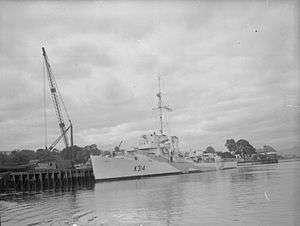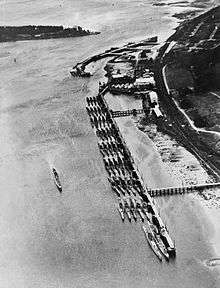Foyle Port

Foyle Port, otherwise known as Londonderry Port, is a port at Lisahally in County Londonderry, Northern Ireland. The United Kingdom’s most westerly and Ireland's most northerly port, Lisahally Terminal has 440 metres (1,440 ft) of quay and can facilitate vessels up to 62,000 GRT. Primarily a bulk port and major importer of oil, coal, animal feed, fertiliser and plywood the port also accepts cruise ships at the city centre berths, at its commercial port at Lisahally as well as the tender port of Greencastle. The current port is on the east bank of the River Foyle at the southern end of Lough Foyle, by the small village of Strathfoyle, about 5 miles (8.0 km) north-east of Derry. It is operated by the Londonderry Port and Harbour Commissioners, whose former offices, just north of the city's walls, are now a museum.
History
Most of the current Londonderry Port is in the townland of Lisahally (or Lissahawley), a toponym that may be derived from Irish Lios a' Chalaidh, meaning "ringfort of the landing place".[1] Known as Lunnonderrie Hairbour in Ulster-Scots,[2] the port has witnessed mass emigration of Irish and Scots-Irish people over the centuries to North America, Scotland, England and Australia.
The port had a thriving shipbuilding business and was known for building clipper ships.[3] Shipbuilding at the port declined after the introduction of iron vessels, and no large ships were built for some decades after 1846. The Foyle Shipyard, founded in 1882, brought shipbuilding back to the port, but it ceased trading in 1892.[4]
The port saw the transport of many goods over the centuries. Seed potatoes were shipped to places as far away as Egypt. Cattle were regularly shipped to and from Glasgow by the Burns and Laird steamer until the late 1960s. Manufactured items including linen, linoleum and shirts were exported to Great Britain for onward distribution. The McCorkell Line sailed from here.
The waterfront area of the city was redeveloped in the 1990s. The cattle holding pens that used to be near where the current British Telecom building stands were demolished along with the transit sheds in order to create a new road and car parking along the banks of the River Foyle. This and with the need for deep water moorings for larger vessels saw the port moved to the docks at Lisahally in 1993. These docks were originally used by DuPont to import raw materials for their manufacturing process and by the nearby Coolkeeragh power station to import fuel oil for their turbines.

Londonderry Port and the docks at Lisahally gave vital service to the Allies in the longest running campaign of World War II, the Battle of the Atlantic. This ended with the surrender of the German U-Boat fleet at Lisahally on 14 May 1945. About a dozen boats came alongside for that official surrender, taken by Admiral Sir Max Horton in the presence of US, Canadian and Republic of Ireland commanders;[5] the other U-boats arrived over the next several weeks. Eventually all were dispatched to sea and sunk.[6]
The port used to have its own railway yard, under the control of the Londonderry Port & Harbour Commissioner (LPHC). This railway had connections to the other railways in Londonderry; The Great Northern and the Northern Counties Committee, both of which were 5ft3, and thanks to dual gauge, the County Donegal Railways Joint Committee and Londonderry & Lough Swilly Railway, which were 3 ft. Wagons could be shunted across the Foyle by way of the lower deck of the Craigavon Bridge, which was dual gauge. Two of the LPHC locomotives survived into preservation- No. 1, which is at the Ulster Folk & Transport Museum in Cultra, and No. 3, which is owned by the Railway Preservation Society of Ireland at Whitehead.
In recent years Londonderry Port and Harbour Commissioners have established a number of diversified trading divisions marketed under the 'Foyle' brand including Foyle Port which incorporates the main cargo handling and general port operations, Foyle Marine Services a division set up to handle the Port’s dredging and towage services as well as offering marine services externally to other ports. Foyle Consulting Engineers is a division set up to provide structural and civil engineering services while Foyle Engineering offers a steel fabrication service.
In July 2003 Foyle Port installed the first of its two permanent pontoons referred to as the Foyle Port Marina in the heart of the city. The marina facility consists of a 200 metres (660 ft) long wooden structure (south), later a second pontoon was established close by comprising a 140 metres (460 ft) concrete structure (north). Overall the Foyle Port Marina offers a total in excess of 600 metres (2,000 ft) of secure deep water berthing.
Lisahally F.C., which is based at the village of Strathfoyle, was founded by port workers from Lisahally.
See also
References
- ↑ "Townland of Lissahawley". Placenames NI - The Northern Ireland Place-Name Project. The Crown. 2009.
- ↑ 2006 annual report in Ulster-Scots North/South Ministerial Council.
- ↑ "Shipbuilding in Londonderry". The Montreal Gazette. 19 May 1913.
- ↑ Cannon, John (2002) [1997]. "Shipbuilding". The Oxford Companion to British History. Oxford University Press. ISBN 0-19-860872-1.
- ↑ Surrender Of German U-Boats - British Pathé. Britishpathe.com. Retrieved on 2013-07-23.
- ↑ Barrow Submariners Association. Rnsubs.co.uk. Retrieved on 2013-07-23.
External links
| Wikimedia Commons has media related to Londonderry Port. |
- Londonderry Port and Harbour Commissioners
- Convoy Map taken from a U-boat that surrendered at Lisahally, County Londonderry.
- HMS Firedrake
55°02′31″N 7°15′47″W / 55.042°N 7.263°W